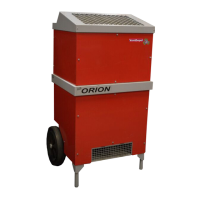Page 4 of 12
Drawing : - TPC381
Issue : - 1
Date : - 09/01/12
BASIC STEPS FOR DRYING
Ensure that all External doors and windows are closed. Where no doors or
windows are fitted, temporarily screen off the openings.
POSITIONING
For small areas position centrally in the area to be dried, for larger areas such
as open plan buildings, offices or factories, a number of dryers may be
required, in such cases they should be spaced evenly around the area.
Ensure that no unit is positioned in such a way that it blows directly into
another.
For private houses or flats, position the dryer on one floor at a time, starting at
the lowest floor, closing all internal doors on the floor previously dried.
Continue until all floor levels have been dried.
Note when a particular damp patch is to be dried out the air outlet grille should
be directed towards that area but should never be closer than 1m to the
surface. At no time should the inlet or outlet grilles be covered or obstructed.
DRAINAGE
Under most operating conditions water will be produced continuously and it is
important that it is drained away correctly and not allowed to spill. Any spillage
will evaporate and will therefore, have to be recycled through the dryer again,
which in effect, only prolongs the drying period.
PORTABLE CONTAINERS
Position a closed top container underneath the water discharge pipe
(approximately 25 litres capacity). Place a short length of pipe one end over
the discharge pipe and the other end in the container. Use a transparent
container, this will enable you to check the level of water and so prevent
overflowing. As the unit will be running for long periods of time, a regular
check should be made on the container water level.
PERMANENT DRAINAGE
Connect a flexible hose to the water drainage pipe of sufficient length so that
it will reach a permanent drain. The gravity head created will allow for a
gradual fall from the unit to the drain. Ensure that the hose is free of kinks and
is not allowed to rise at any point above the level of the discharge point from
the dehumidifier. Any air locks which may be created, should the level be
raised by the hose passing over obstructions, could cause the water to “back
up” the hose and spill from the drier.

